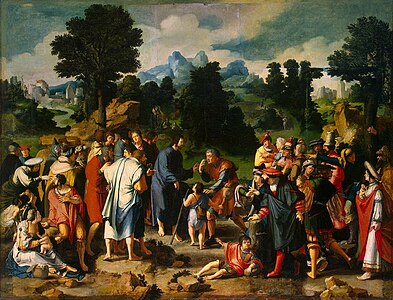Lucas van Leiden
Lucas van Leyden (Leiden, South Holland, 1494-1533), whose real name was Lucas Hugensz, Lucas Huygenz or Jacobsz, was a Dutch painter and printmaker. He stood out among the early members of Dutch genre painting and is considered one of the most brilliant printmakers in the history of art.
Life and work
He studied with his father, who was a painter, and with Cornelis Engebrechtsz, also a Dutch painter, showing an early aptitude for the art of engraving. Among his first plates, there is a Mary Magdalene in the desert that he was able to engrave when he was barely 13 years old.
He made more than 200 burin engravings, etchings, and designs for woodcuts, most of them religious or allegorical, in which he stood out as an accomplished draughtsman.
His work is marked by a monumental sense in the composition of the figures, the use of aerial perspective, meticulousness in the clothing and naturalism in the characterization of the characters. His first series of plates on the Passion of Jesus Christ, made in 1509, already show the mastery of the artist. In 1510, when he was barely 16 years old, he signed two plates, Christ Presented to the People ( Ecce Homo ) and The Milkmaid , which would be admired by Rembrandt. In his youthful production, the influence of Dürer was evident, which later faded (c. 1518-20), until a direct encounter with him revived it.
In 1520-21 Dürer traveled to Aachen to renew certain privileges with the new Emperor Charles I, and then toured various cities in the Netherlands. Then Van Leyden and Dürer met; they became friends and Van Leyden adopted some technical tricks that the German genius told him about. Dürer also expressed admiration for Van Leyden, and proof of this is that he bought him a complete set of all his engravings, as he noted in his account book. Evidence of this encounter is the Portrait of Lucas van Leyden, a drawing by Dürer kept at the Palais des Beaux-Arts in Lille.
From then on, the influence of the Italian Renaissance grew in Van Leyden, due to the greater interest in mythological subjects and nudes. A healthy competition led him to exacerbate his perfectionism, further raising the quality of his small plates. He then absorbed influences from Jan Gossaert and the incipient French mannerism.
Van Leyden's prints, treasured from an early date as collector's jewels, are located in multiple libraries and museums around the world. The Plantin-Moretus Museum in Antwerp preserves 15 original copper matrices by the artist. In Spain, the collection of the National Library in Madrid should be highlighted, although the collecting of engravings had a limited diffusion in this country.
In comparison, his paintings are simpler and less accomplished, and very few are of secure authorship. Of Lucas's pictorial production, The Chess Game (1508, Gemäldegalerie in Berlin), The Last Judgment (1526-1527, Municipal Museum De Lakenhal, Leiden, Netherlands) stands out.) and Christ Presented to the People (1530, Metropolitan Museum, New York). In Spain there is hardly a reliable example, Partida de cartas (Madrid, Museo Thyssen-Bornemisza), where the three players have identified themselves as high-ranking European dignitaries, in an allegory of the complex political situation that lived then.
Gallery
Contenido relacionado
Fiberglass
Persia (region)
Isabella rossellini



